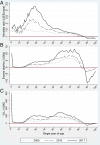Excess mortality in the United States in the 21st century
- PMID: 33846260
- PMCID: PMC8072323
- DOI: 10.1073/pnas.2024850118
Excess mortality in the United States in the 21st century
Abstract
We use three indexes to identify how age-specific mortality rates in the United States compare to those in a composite of five large European countries since 2000. First, we examine the ratio of age-specific death rates in the United States to those in Europe. These show a sharp deterioration in the US position since 2000. Applying European age-specific death rates in 2017 to the US population, we then show that adverse mortality conditions in the United States resulted in 400,700 excess deaths that year. Finally, we show that these excess deaths entailed a loss of 13.0 My of life. In 2017, excess deaths and years of life lost in the United States represent a larger annual loss of life than that associated with the COVID-19 epidemic in 2020.
Keywords: age-specific death rates; international comparisons; mortality.
Copyright © 2021 the Author(s). Published by PNAS.
Conflict of interest statement
The authors declare no competing interest.
Figures

Comment in
-
The COVID-19 pandemic adds another 200,000 deaths (50%) to the annual toll of excess mortality in the United States.Proc Natl Acad Sci U S A. 2021 Sep 7;118(36):e2107590118. doi: 10.1073/pnas.2107590118. Proc Natl Acad Sci U S A. 2021. PMID: 34446539 Free PMC article. No abstract available.
-
Reply to Heuveline: Important extension of analysis.Proc Natl Acad Sci U S A. 2021 Sep 7;118(36):e2109981118. doi: 10.1073/pnas.2109981118. Proc Natl Acad Sci U S A. 2021. PMID: 34446540 Free PMC article. No abstract available.
Similar articles
-
Excess mortality from COVID and non-COVID causes in minority populations.Proc Natl Acad Sci U S A. 2021 Sep 28;118(39):e2101386118. doi: 10.1073/pnas.2101386118. Proc Natl Acad Sci U S A. 2021. PMID: 34544858 Free PMC article.
-
Real-time monitoring shows substantial excess all-cause mortality during second wave of COVID-19 in Europe, October to December 2020.Euro Surveill. 2021 Jan;26(2):2002023. doi: 10.2807/1560-7917.ES.2021.26.1.2002023. Euro Surveill. 2021. PMID: 33446304 Free PMC article.
-
The mortality burden related to COVID-19 in 2020 and 2021 - years of life lost and excess mortality in 13 countries and sub-national regions in Southern and Eastern Europe, and Central Asia.Front Public Health. 2024 Jun 6;12:1378229. doi: 10.3389/fpubh.2024.1378229. eCollection 2024. Front Public Health. 2024. PMID: 38903591 Free PMC article.
-
One hundred thirty-three observed COVID-19 deaths in 10 months: unpacking lower than predicted mortality in Rwanda.BMJ Glob Health. 2021 Feb;6(2):e004547. doi: 10.1136/bmjgh-2020-004547. BMJ Glob Health. 2021. PMID: 33627363 Free PMC article. Review.
-
[SENTIERI - Epidemiological Study of Residents in National Priority Contaminated Sites. Sixth Report].Epidemiol Prev. 2023 Jan-Apr;47(1-2 Suppl 1):1-286. doi: 10.19191/EP23.1-2-S1.003. Epidemiol Prev. 2023. PMID: 36825373 Italian.
Cited by
-
The "double jeopardy" of midlife and old age mortality trends in the United States.Proc Natl Acad Sci U S A. 2023 Oct 17;120(42):e2308360120. doi: 10.1073/pnas.2308360120. Epub 2023 Oct 9. Proc Natl Acad Sci U S A. 2023. PMID: 37812715 Free PMC article.
-
Is Covid-19 a dread risk? The death toll of the pandemic year 2020 in long-term and transnational perspective.Futures. 2022 Sep;142:103017. doi: 10.1016/j.futures.2022.103017. Epub 2022 Aug 10. Futures. 2022. PMID: 35967763 Free PMC article.
-
The impact of early death on birth counts in the United States, 1950 to 2019.PNAS Nexus. 2024 Jun 7;3(6):pgae058. doi: 10.1093/pnasnexus/pgae058. eCollection 2024 Jun. PNAS Nexus. 2024. PMID: 38854911 Free PMC article.
-
Reply to Polizzi and Dowd: Within-country counterfactual reveals importance of retirement age mortality in addition to established concern about working ages.Proc Natl Acad Sci U S A. 2024 Jan 23;121(4):e2320028121. doi: 10.1073/pnas.2320028121. Epub 2024 Jan 16. Proc Natl Acad Sci U S A. 2024. PMID: 38227670 Free PMC article. No abstract available.
-
The heritability and persistence of social class in England.Proc Natl Acad Sci U S A. 2023 Jul 18;120(29):e2309250120. doi: 10.1073/pnas.2309250120. Epub 2023 Jul 5. Proc Natl Acad Sci U S A. 2023. PMID: 37406089 Free PMC article. No abstract available.
References
-
- Crimmins E. M., Preston S. H., Cohen B., Eds., Explaining Divergent Levels of Longevity in High-Income Countries (National Academies Press, 2011). - PubMed
-
- National Research Council and Institute of Medicine , U.S. Health in International Perspective: Shorter Lives, Poorer Health (National Academies Press, 2013). - PubMed
Publication types
MeSH terms
Grants and funding
LinkOut - more resources
Full Text Sources
Other Literature Sources
Medical

